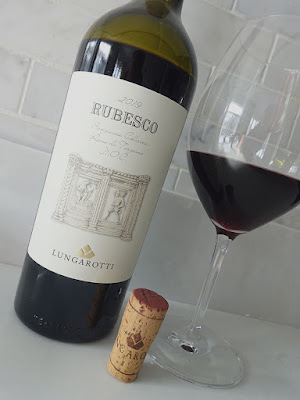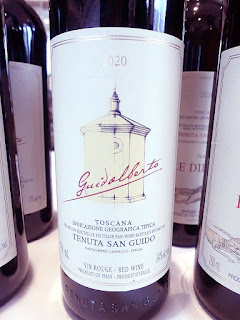red wine review is this lovely Pinot Noir from Martinborough in New Zealand that arrived at the LCBO last month in the LCBO VINTAGES New Release Collection.
It is produced by Luna Estate, a winery that was established in 2000 and is situated in the beautiful Wairarapa wine region, in the southern part of the North Island in New Zealand. Luna Estate is named after the moon because of its unifying qualities - because it doesn't matter where you are on the planet, we all see the same moon. At the heart of the operation is their sustainable and organic principles, which drive the farming process, while in the winery they let the grapes do the talking. Luna Estate looks after their land and soils, employing regenerative and organic farming principles and practices across both of their vineyards, eliminating the need for harmful herbicides and pesticides in their ecosystems, because better and cleaner farming is good for all of us.
Two vineyards make up Luna Estate. The Eclipse Vineyard, which is tended to organically, lies in the heart of the terrace on Puruatanga Road, where planting began in 1992 with Pinot Noir and Chardonnay vines that now form the core of Luna's higher-tier bottlings. While these vineyards are relatively new, they owe gratitude to government scientists in the 1970s who suggested that the climate, combined with an ancient rocky riverbed to the east of the village, might make Martinborough a suitable place for winegrowing. Pioneers experimented by planting several grape varieties over the years and determined that Pinot Noir fared very well, leading to justifications now that Martinborough is among the top Pinot Noir grape growing regions on the planet.
The Blue Rock Vineyard is their north-facing, hillside vineyard with silty clay loams interspersed with ancient marine sediment soils, located approximately 12 km south of Martinborough on Dry River Road. Planting at Blue Rock began in 1986, with some of the vines still producing grapes today. This vineyard is also in the process of converting to full organic practices.
This 100% Pinot Noir is crafted using only estate grown fruit that was harvested from their Eclipse and Blue Rock vineyards, with the majority coming from younger vines growing on the clay/limestone hillside of the Blue Rock Vineyard. All of the fruit is de-stemmed and gently transferred into 6 ton open-top temperature-controlled stainless steel fermenters. After the fruit is chilled down and held for a 5-6 day cold soak to aid in colour and flavour extraction, the cooling is turned off and a temperature-controlled fermentation begins. The total maceration time was between 15–30 days before gentle pressing. It was matured in oak for 10 months, then bottled with minimal fining and gentle filtration, without the use of any animal products throughout the entire process.
The 2019 vintage began with winter arriving late and a cold and wet August and September, as well as a catastrophic frost in late spring which resulted in heavy losses across the region. Their Eclipse vineyard was struck across the blocks closest to the terrace edge, with losses estimated at around 30%. Spring was very challenging with high rainfall in November impacting the flowering stage, significantly reducing crop levels and making the vineyard work extremely difficult. Summer was hot and relatively dry, while harvest was early again with perfect weather for picking. In spite of the challenges, the quality of the fruit harvested was excellent, albeit in small quantities.
After enjoying the lovely 2016 Luna Estate Pinot Noir a couple of years ago, let's see how this latest vintage of Pinot Noir from NZ is tasting tonight...
Screw cap. The fragrant, highly aromatic nose is rich and spicy with attractive aromas of black and red cherry, strawberry, beetroot, and earth, plus hints of tea leaf and dried herbs. It's light-to-mid weighted on the palate with light, fine-grained tannins and juicy acidity that supports the black and red cherry, strawberry, spices, stony mineral, and earth flavours complementing each other quite nicely. It's well-balanced and nicely composed throughout. Pleasing chalky textured mouthfeel on the mid-palate, while stony mineral and spicy notes linger on the long, juicy, and savoury finish. Will drink well over the next 3-4 years. Highly recommended buy! Score: 91+ pts
Limited quantities of other Luna Estate wines are available at the LCBO, while the entire portfolio can be ordered through their Agent - Noble Estates Wines & Spirits.
It is produced by Luna Estate, a winery that was established in 2000 and is situated in the beautiful Wairarapa wine region, in the southern part of the North Island in New Zealand. Luna Estate is named after the moon because of its unifying qualities - because it doesn't matter where you are on the planet, we all see the same moon. At the heart of the operation is their sustainable and organic principles, which drive the farming process, while in the winery they let the grapes do the talking. Luna Estate looks after their land and soils, employing regenerative and organic farming principles and practices across both of their vineyards, eliminating the need for harmful herbicides and pesticides in their ecosystems, because better and cleaner farming is good for all of us.
Two vineyards make up Luna Estate. The Eclipse Vineyard, which is tended to organically, lies in the heart of the terrace on Puruatanga Road, where planting began in 1992 with Pinot Noir and Chardonnay vines that now form the core of Luna's higher-tier bottlings. While these vineyards are relatively new, they owe gratitude to government scientists in the 1970s who suggested that the climate, combined with an ancient rocky riverbed to the east of the village, might make Martinborough a suitable place for winegrowing. Pioneers experimented by planting several grape varieties over the years and determined that Pinot Noir fared very well, leading to justifications now that Martinborough is among the top Pinot Noir grape growing regions on the planet.
The Blue Rock Vineyard is their north-facing, hillside vineyard with silty clay loams interspersed with ancient marine sediment soils, located approximately 12 km south of Martinborough on Dry River Road. Planting at Blue Rock began in 1986, with some of the vines still producing grapes today. This vineyard is also in the process of converting to full organic practices.
This 100% Pinot Noir is crafted using only estate grown fruit that was harvested from their Eclipse and Blue Rock vineyards, with the majority coming from younger vines growing on the clay/limestone hillside of the Blue Rock Vineyard. All of the fruit is de-stemmed and gently transferred into 6 ton open-top temperature-controlled stainless steel fermenters. After the fruit is chilled down and held for a 5-6 day cold soak to aid in colour and flavour extraction, the cooling is turned off and a temperature-controlled fermentation begins. The total maceration time was between 15–30 days before gentle pressing. It was matured in oak for 10 months, then bottled with minimal fining and gentle filtration, without the use of any animal products throughout the entire process.
The 2019 vintage began with winter arriving late and a cold and wet August and September, as well as a catastrophic frost in late spring which resulted in heavy losses across the region. Their Eclipse vineyard was struck across the blocks closest to the terrace edge, with losses estimated at around 30%. Spring was very challenging with high rainfall in November impacting the flowering stage, significantly reducing crop levels and making the vineyard work extremely difficult. Summer was hot and relatively dry, while harvest was early again with perfect weather for picking. In spite of the challenges, the quality of the fruit harvested was excellent, albeit in small quantities.
After enjoying the lovely 2016 Luna Estate Pinot Noir a couple of years ago, let's see how this latest vintage of Pinot Noir from NZ is tasting tonight...
Tasting Note:
LUNA ESTATE PINOT NOIR 2019 - Sustainable, Martinborough, North Island, New Zealand (#17544) (XD) - $27.95Screw cap. The fragrant, highly aromatic nose is rich and spicy with attractive aromas of black and red cherry, strawberry, beetroot, and earth, plus hints of tea leaf and dried herbs. It's light-to-mid weighted on the palate with light, fine-grained tannins and juicy acidity that supports the black and red cherry, strawberry, spices, stony mineral, and earth flavours complementing each other quite nicely. It's well-balanced and nicely composed throughout. Pleasing chalky textured mouthfeel on the mid-palate, while stony mineral and spicy notes linger on the long, juicy, and savoury finish. Will drink well over the next 3-4 years. Highly recommended buy! Score: 91+ pts
Limited quantities of other Luna Estate wines are available at the LCBO, while the entire portfolio can be ordered through their Agent - Noble Estates Wines & Spirits.










































